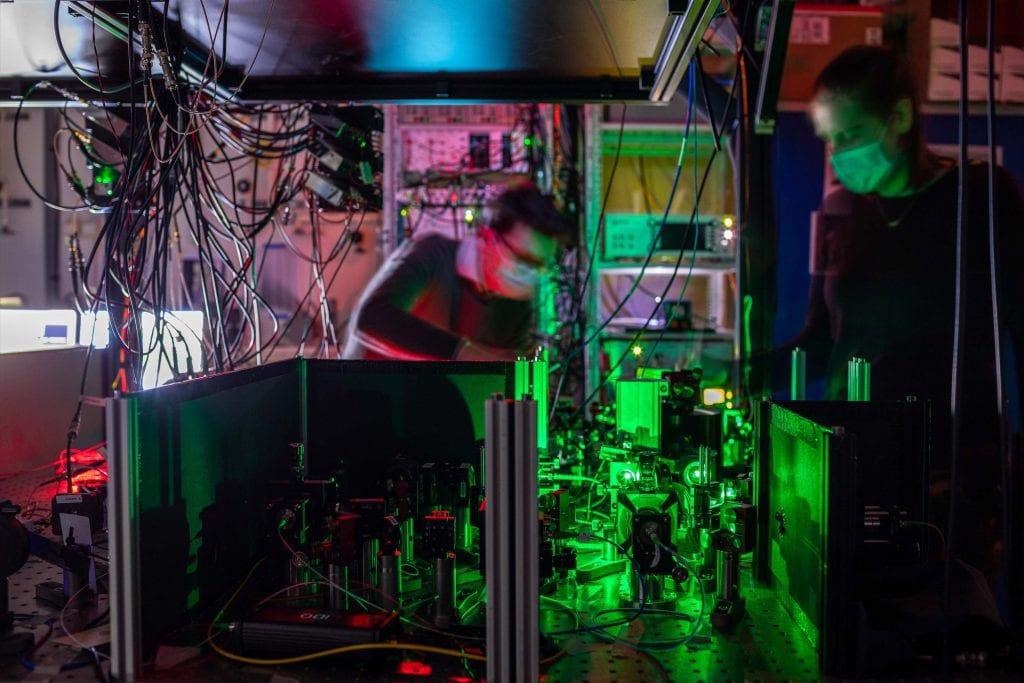Apr 16 2021
QuTech researchers from the Netherlands have achieved the world’s first multi-node quantum network by linking three quantum processors.
 Researchers work on one of the quantum network nodes, where mirrors and filters guide the laser beams to the diamond chip. Image Credit: Marieke de Lorijn for QuTech.
Researchers work on one of the quantum network nodes, where mirrors and filters guide the laser beams to the diamond chip. Image Credit: Marieke de Lorijn for QuTech.
The team has also demonstrated a proof-of-principle related to major quantum network protocols. Recently published in the Science journal, the findings represent a major milestone toward the upcoming quantum internet.
The Quantum Internet
With the power of the Internet, any two computer systems on Earth can be linked to one another, facilitating applications that were not envisaged during its invention many years ago.
At present, scientists in several laboratories worldwide are working toward the initial models of a quantum internet—a network that can link a pair of quantum devices, like quantum sensors or computers, across vast distances.
While present-day Internet distributes data in the form of bits, which can be either 1 or 0, the next-gen quantum internet will use quantum bits that can be both 1 and 0 simultaneously.
A quantum internet will open up a range of novel applications, from unhackable communication and cloud computing with complete user privacy to high-precision time-keeping. And like with the Internet 40 years ago, there are probably many applications we cannot foresee right now.
Matteo Pompili, PhD Student and Team Member, QuTech, Delft University of Technology
Toward Ubiquitous Connectivity
In the last 10 years, initial steps had been taken toward a quantum internet by connecting a pair of quantum devices that had a direct physical link in common. But the ability to pass on quantum data via intermediate nodes (similar to routers in the traditional internet) is important for producing a quantum network that can be scaled up.
Moreover, several potential quantum internet applications depend on entangled quantum bits, to be spread between numerous nodes.
Entanglement is a kind of phenomenon that can be seen at the quantum scale, essentially linking particles at small distances and even at large ones.
Entanglement provides enormous computational power to quantum computers and it is the crucial resource for sharing quantum data across the next-gen quantum internet.
By achieving their quantum network in the laboratory, the research team from QuTech—an association between TNO and the Delft University of Technology—is the first to link a pair of quantum processors via an intermediate node and to establish the shared entanglement between various independent quantum processors.
Operating the Quantum Network
The fundamental quantum network contains three quantum nodes, at a certain distance inside the same building. To make these nodes work as an actual network, the team first needs to develop an innovative architecture that helps scale up beyond one solitary link.
The middle node, known as Bob, has a physical link with both the external nodes (known as Charlie and Alice), making it possible to establish entanglement links with each of these nodes.
Bob is fitted with an extra quantum bit that can be utilized as memory. This helps store a formerly generated quantum link while a new connection is being established.
Once the quantum links Bob–Charlie and Alice–Bob are established, a series of quantum operations at Bob changes these links into a quantum link Alice-Charlie. On the other hand, entanglement between all three nodes is established by doing a different set of quantum operations at Bob.
Ready for Subsequent Use
A significant feature of this network is that it reports the effective completion of these (intrinsically probabilistic) procedures with a 'flag' signal. This heralding is important for scalability because in next-gen quantum internet, most of these procedures will need to be concatenated.
Once established, we were able to preserve the resulting entangled states, protecting them from noise. It means that, in principle, we can use these states for quantum key distribution, a quantum computation or any other subsequent quantum protocol.
Sophie Hermans, Team Member, QuTech, Delft University of Technology
Quantum Internet Demonstrator
The first entanglement-based quantum network offers the investigators a special testbed for designing and validating quantum internet hardware, protocols, and software.
“The future quantum internet will consist of countless quantum devices and intermediate nodes. Colleagues at QuTech are already looking into future compatibility with existing data infrastructures,” stated Ronald Hanson, who headed the research group.
In due course, the present proof-of-principle technique will be tested beyond laboratory settings on prevalent telecom fiber—on QuTech’s Quantum Internet Demonstrator, of which the initial metropolitan link is set to be finished in 2022.
Higher-Level Layers
In laboratory settings, the team will focus on introducing additional quantum bits to their three-node network and on introducing higher level hardware and software layers.
Once all the high-level control and interface layers for running the network have been developed, anybody will be able to write and run a network application without needing to understand how lasers and cryostats work. That is the end goal.
Matteo Pompili, PhD Student and Team Member, QuTech, Delft University of Technology
Journal Reference:
Pompili, M., et al. (2021) Realization of a multinode quantum network of remote solid-state qubits. Science. doi.org/10.1126/science.abg1919.